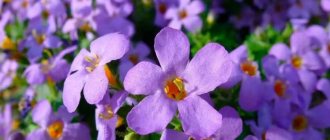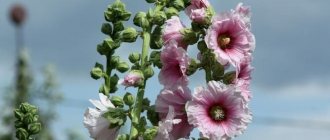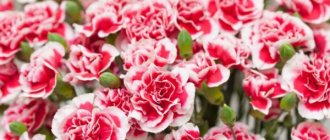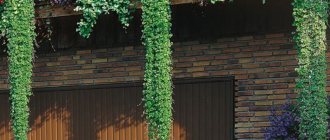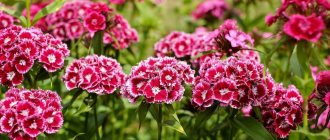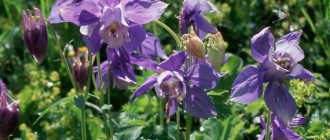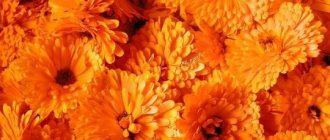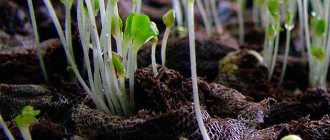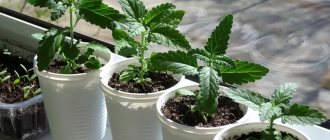Eschscholzia belongs to the Poppy family, which includes several dozen different species. This plant was first found in North America, in its western part.
Its color resembles gold, which is why the Spaniards jokingly call Eschscholzia the golden cup. The plant is very beautiful and romantic, but does not require special care and is becoming increasingly popular in cultural cultivation.
Description and features
It is a herbaceous perennial shrub with a tap-shaped root. The shoots are thin and numerous. The flowers resemble poppies, colors range from yellow to red and their shades, single or double, depending on the variety.
Blooms from summer until winter. However, one bud lives only a few days; it is replaced by a larger number, approximately 1/2. The hallmark of this plant is not only the delicate flowers, but also the white, bluish coating on the stems and leaves.
Type and varieties of Eschscholzia
In nature and in gardens, both single species and inflorescences are found.
Californian
The most common. In addition, all the varieties under consideration are varieties of Californian.
The plant is perennial, spreading along the ground. It has fairly strong stems, of medium height, about 50 cm in height. The buds are single, 8 cm in diameter.
| Variety | Description |
| Strawberry | Flowers with a semi-double structure are also common. Presented in a gradient of 2 colors, red and yellow. Does well in rocky soil. |
| Peach sherbet | This variety has flowers that are only semi-double and have a creamy, beige color. The number of petals is large, reaching 12 pieces. The height of the stem is slightly less, 25 cm. |
| Carminking | Height is about 30 cm, flowers are up to 8 cm in diameter. The petals have ruby color. |
| apple blossom | Bright pink double flowers. A distinctive feature is dense foliage, a large number of stems and buds. |
| Chiffon | As you know, hybrids take the best from their ancestors. The advantages of this variety are its record flowering. It begins in early May and ends when frost sets in. The buds have a terry structure and their color is unique. Blooms in groups, with each flower having its own shade. |
| Ballerina mix | Hybrid. It has regular and double buds in its arsenal. Their shades range from light pink to orange. The flowers themselves are quite large, about 9 cm in diameter. Stems are medium, 40 cm. |
| Mikado | The shoots are medium, up to 40 cm in height. The buds are large, about 7 cm in diameter. Has straight petals. The color is a gradient of orange and bright yellow. |
Botanical description of the flower
The peculiarity of Eschsolzia is not only in the uniqueness of the structure or the legend of its origin. An annual flower is:
- bushy plant;
- in the wild it is a perennial crop, but is cultivated as an annual to enhance its decorative qualities;
- height no more than 40 cm;
- Reminds me of a poppy.
The color scheme is varied: yellow, red, white, bright orange. The botanical description of the culture standard is:
| Parts | Characteristic |
| Root | Rod, medium length |
| Stem | Many branches, thin |
| Green part | The foliage is openwork with deep dissection and long petioles. Color: bluish-green. |
| Bud | Single. Cup-shaped. Diameter: 6-8 cm |
| Petals | Either terry or simple (depending on the type) |
| Seeds | After flowering, a capsule is formed. Reaches 9 cm in diameter |
Interesting fact! The Eschscholzia bud reacts very strongly to changes in weather conditions. It can be used to accurately predict thunderstorms, rain, and cloudy days, since at such moments it does not open. With the onset of dusk, the flower also falls asleep and collects its petals in a tight box.
Growing Eschscholzia from seeds
The simplest and most effective method of propagation is seed. Seeds can be stored for a long time, while they retain their properties.
Sowing dates, pros and cons
An excellent solution would be to plant the seeds in the fall. This allows them to be stratified 100%. Moreover, the weaker ones simply do not survive in such conditions, and the flowering of eschscholzia will be early. To do this, you need to prepare special grooves, about 5 cm deep.
Seeds are sown by lightly pressing them into the soil. Mulch from loose humus is poured on top of them; its layer is no more than 2 cm thick. This is done to prevent the soil from freezing where the plant is planted, as this greatly impedes the development of the root system.
Autumn sowing usually occurs in October. Mainly in dry weather, only with the onset of frost.
Some people, on the contrary, prefer to plant seeds in the spring. However, to do this, they need to undergo certain training before disembarking. They are placed in a special cotton bag, and it is already in the refrigerator on the bottom shelf. They need to be stored there for at least a month before planting.
How to grow eschsolzia seedlings
Eschscholzia is usually grown from seeds. Under certain conditions and warm climates, you can plant directly in the ground, but it is better to use the seedling method.
Seed selection and preparation
The seeds of the poppy family are very small in size. You can collect them yourself from ripe poppy pods.
The boxes ripen about a month after flowering has completed, approximately this occurs closer to October. They are carefully cut and dried, then the seeds are collected in a separate container. The seeds can be planted over three seasons.
You can also buy ready-made seeds at a specialty store. The advantage is a large selection of varieties, including hybrids. A mixture of several varieties will look aesthetically pleasing on a summer cottage.
In order for the seeds to germinate, it is necessary to stratify and awaken them. To do this, the seeds are placed in starved water for 12 hours. To disinfect the seed, potassium permanganate, phytosporin or copper sulfate must be added to the water.
After this, the seeds are ready for sowing.
Soil selection and preparation
Soil for Eschscholzia is a mixture of turf soil and humus, which you can buy or mix yourself. The soil mixture is first disinfected with a solution of potassium permanganate and calcined in the oven for 30 minutes.
Selection of capacity
The root system of Eschscholzia is not suitable, it is quite fragile, and is not suitable for replanting, so in order not to disturb the plants once again, it is better to immediately plant it in separate containers: pots or special cassettes in the form of honeycombs.
You can take special tablets. When the time comes to transplant seedlings into the ground, the seedling is placed in the hole along with the tablet and over time it dissolves
Sowing seeds
To plant seeds, you need to fill the containers with prepared soil. Next, make a hole in the center with a toothpick and place one seed there, sprinkled with a thin layer of earth (maximum 5 mm). The containers are covered with film and kept for a week and a half until the first shoots. Condensation must be removed from the film periodically.
What care do seedlings need?
In order for seedlings to sprout, they must be properly cared for. It is necessary to maintain a comfortable temperature and humidity for the sprouts. If necessary, add additional light, fertilize, and water.
Temperature and humidity
Before emergence, the optimal temperature for seedlings is 18°C. Then they feel great at room temperature on the window. The temperature should not be allowed to drop to 16 or even lower.
Drafts and excessive heat (over 25 degrees) are unacceptable.
Lighting
Natural lighting is suitable for Eschsolzia. The flower originated from wild poppy and is resistant to changing environmental conditions. But of course, you shouldn’t keep it in the dark, and wait until the daylight hours become longer than the night.
Watering and fertilizing
Seedlings should be watered as the soil dries out; a spray bottle is used for this. When watering, water should not fall on the plants; excess moisture is removed through the drainage holes.
It is customary to fertilize the soil even before planting seeds for seedlings, so that the young shoots have enough of everything. But situations are different, and sometimes you still need to feed
To determine whether feeding is needed or not, look at the appearance of the plants:
- If the leaves are pale in color, then the plants need nitrogen. In this case, a solution of cow dung or urea is used. This feeding of seedlings can only be done once.
- If the plant turns purple, it means there is a lack of phosphorus. You need a solution of superphosphate + water 2 g and 1 l, respectively.
- If the leaves begin to dry out, use a solution of potassium sulfate + water 3 g and 1 l, respectively.
Feeding should be done approximately once a week. Gardeners recommend using mineral and organic complexes alternately.
You can also use purchased products, such as Nitrofak, Kemir, or growth stimulants such as Epin or Zircon. They need to be diluted according to the instructions.
It is important not to exceed the specified dosages, otherwise the seedlings may be destroyed
Technology for sowing Eschscholzia at home
The plant does not tolerate transplantation at all, but this does not stop flower growers. Around the beginning of March, you can start growing eschscholzia on the windowsill in your apartment, but not using the usual method. Only peat tablets are used. This is done in order not to damage the root system of the plant during transplantation.
The tablet is placed in water to soften it. Then 2-3 seeds are placed into it using a toothpick. After which they are sprinkled with peat, and the surface is moistened.
It is recommended to cover the seedlings with plastic film; the greenhouse effect will allow for faster seed germination. When the first shoots appear, the film must be removed and the seedlings themselves must be placed in a cooler, bright place.
15 days after germination, you need to feed the plants with a special mineral mixture.
If it is necessary to transport the plant to open ground, this is done together with the tablet; it decomposes in the soil, and the root system is not damaged in any way during transplantation.
About 3 weeks before planting seedlings in open soil, hardening of the seedlings begins.
This is done by placing the container with the sprouts in the open air for several hours. Hardening is necessary so that when transplanted into open ground, the plant does not die from sub-zero soil temperatures.
Advantages of application in landscape design
To grow a flower garden in your garden that will attract the attention of others, there are a huge number of varieties and types of crops.
But growing Eschscholzia is more profitable than other proposals. In addition to the diversity of the color palette, the plant is distinguished by its constant flowering until the first frost.
The buds bloom in early summer. The duration of the process is 3-5 days. But as soon as one bud fades, a new one appears in its place.
Due to the constant replenishment of flowers, Eschscholzia forms a colorful living carpet. The gardener is required to monitor the removal of faded buds to ensure timely replenishment of inflorescences.
Planting Eschscholzia in open ground
Sandy soil is recommended for planting; it must be well drained.
Landing dates
Seedlings should be transplanted into the soil when the threat of frost has passed. Usually this is May-April.
However, it all depends on the landing region.
Landing Features
Initially, it is necessary to prepare small planting holes. Keep a distance between them of at least 30 cm, this is due to the strong spreading nature of the bushes. The seedling is immersed in a pre-dug hole along with a peat tablet, after which it is sprinkled with soil, then compacted. After this, water it. Flowering is observed after about a month.
When to plant Eschscholzia
It is necessary to plant Eschscholzia in dry, sandy soil with a good drainage layer. The reaction must be neutral or slightly acidic. If the soil on your site is too acidic, then you should dig it with a shovel full and at this depth lay out dolomite flour at the rate of 200 grams per square meter. Flour can be replaced with ash. For one square meter of land you will need two cups of ash. Seedlings can be planted from late April to mid-May. This is the period when frosts no longer appear at night, but the earth is not yet completely warmed up.
Caring for Eschscholzia in open ground
This plant is unpretentious by nature, requiring only fertilizing and timely watering. The latter must be carried out exclusively in the evening, before sunset. In this case, the flow of water must be directed precisely under the root of the plant so as not to affect the inflorescences or damage them.
Mineral fertilizer with a predominance of phosphorus, nitrogen and potassium is excellent for feeding. It promotes overall plant growth and an increase in the number of inflorescences.
Organics are highly not recommended; because of it, the Eschscholzia will die.
To allow air to reach the roots, the soil must be loosened regularly, and dried buds must be destroyed in a timely manner.
Popular varieties
Apricot chiffon
Perennial Eschscholzia bushes are covered with creamy apricot flowers. They grow to a height of 35-40 centimeters. The flowers of this variety are double with corrugated petals.
Golden glory
Large simple yellow flowers with an orange center.
Orange King
Has bright orange inflorescences. The diameter of the flower is 5-8 centimeters. Blooms from June to October.
Mikado
This variety belongs to the Californian Eschsolzia. It has bright yellow flowers with an orange center and is 7 centimeters in diameter.
Karminkoenig
Simple flowers are dark carmine in color.
Strawberry fields
This variety has semi-double, scarlet flowers with a yellowish center.
Fruity explosion
The name of the flowers comes from the combination of bright, rich colors of yellow and crimson; their shape can be wide and folded.
Apple tree flowers
The varietal species is distinguished by increased color of large inflorescences. Their color is pink, but has a bright tint at the edges and a pale tint in the middle.
Eschscholzia after flowering
At the end of flowering, the seeds are collected and the plant is prepared for wintering.
Collecting seeds
In general, Eschscholzia reproduces well by self-seeding, so collecting seeds is not necessary. If in the future it is planned to plant the plant in the same place, you can “let the process take its course.” Next spring, several dozen beautiful flowers will delight the eye. However, if they are supposed to be planted in another place, it is necessary to put special gauze bags on the flowers. Then, after 4 weeks, cut off the seed pods and only then remove the seeds.
Gauze bags allow you to isolate seeds from the outside world, thereby preventing the emergence and development of various diseases. I dry it and then put it in the refrigerator for storage.
Preparing for winter
In the fall, the remains of plants are cut off and the area is thoroughly dug up. In the spring, strong stems will definitely appear there; they will be thinned out and fed. In just a month they will already bloom.
Collecting seeds
If you plan to plant Eschscholzia seeds on your plot again next year, then it is not at all necessary to collect seed material, since the plant can give excellent self-seeding. This will save you from the unnecessary hassle of stratification, planting, etc. In the spring, you will only have to thin out the seedlings in the beds and calmly wait until the eschscholzia blooms.
In general, seeds are needed only in the first year of planting a plant on the site, and then you will no longer have to purchase them in the store. If you don’t trust self-sowing or want to transplant the plant to another area, then you will have to collect the seeds. It's not difficult to do this. Look for a few bushes in advance, put gauze bags on the wilted flowers so that the seeds do not spill out on the ground, and as soon as they ripen (about a month after flowering stops), the seed pods can be safely cut off, remove the gauze, and shake out the contents , preferably on newspaper, and then leave in a warm, dry place to dry. After this, the seed is collected in a paper bag and left in the bottom drawer of the refrigerator until spring, this was noted earlier in the article.
If the seeds were collected correctly and stored under normal conditions, their germination will continue for three years.
Diseases and pests
Eschscholzia is highly resistant to various kinds of diseases, but does not have immunity from all diseases. The most common problem with this plant is root rot. It is caused by excess moisture in the soil. This disease manifests itself by the wilting of the flower. The only way to know for sure is to dig up the root. If there is a gray coating on it, then it is gray rot. The affected plant is removed, its neighbors are treated with a fungicidal solution, and watering is temporarily stopped.
During dry periods, the main problem is spider mites. It manifests itself by enveloping the leaves in cobwebs, and on the leaves themselves you can observe small, running dots. Acaricides are ideal for treatment.
Aphids are also a common problem with Eschscholzia. However, it is easy to cope with it; it is necessary to spray the affected plant with cold water, and pollinate it and neighboring plants with a fungicidal solution.
Mister summer resident recommends: medicinal properties of eschsolzia
In fact, every plant in nature has a special purpose. The same is true with this flower. The ancient Indians long ago studied the issue of the medicinal properties of eschscholzia. With its help, they relieved toothache and fought lice. Even pollen was used; it was used to improve skin elasticity and restore its former attractiveness. Modern medicine uses the extract of this plant as one part of multicomponent medications. It is included in sedatives and pain relievers. In addition, medicines based on eschsolzia are 100% safe, which allows them to be used by all people, regardless of age or individual problems with the body.
However, it is worth keeping in mind that nothing is perfect, and eschscholzia-based drugs also have side effects that can only develop if the dosage is exceeded. These include the development of allergies. It does not matter in what form the medicine was used. There may be a decrease in effectiveness, which often leads to an increase in dosage. To avoid unpleasant consequences, you must strictly follow the doctor's instructions.

